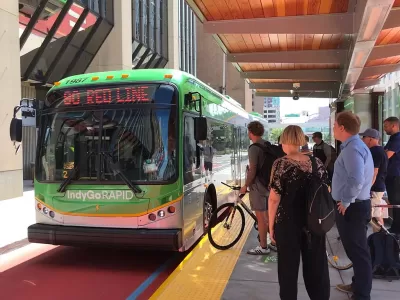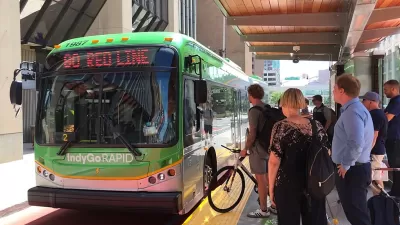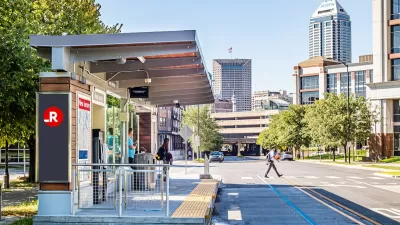IndyGo is planning changes to the Blue Line. The city’s third bus rapid transit route is turning out to be much more expensive than originally expected.

“IndyGo is considering changes to the route for the Blue Line, the transit agency's third bus rapid transit line connecting Cumberland to the Indianapolis International Airport, in light of ballooning project cost estimates,” reports Kayla Dwyer for the Indianapolis Star.
Labor shortages and supply chain issues are blamed for increasing estimated costs on the project from $220 million in 2019 to $520 million in 2022. “Another major cost increase is attributable to city and Citizens Energy Group standards for drainage that have changed since work on the Blue Line began in 2018,” according to a source cited by Dwyer in the article. “Drainage costs alone comprise 42% of the total construction cost, whereas they comprised 18% of the Purple and Red Line costs.”
“To cut costs, IndyGo is proposing diverting the bus rapid transit route to I-70 between Holt Road and the airport, rather than using Washington Street,” reports Dwyer. “That would save in capital costs and travel time to the airport, but it would also mean no new stops west of Holt Road and no immediate infrastructure improvements to that stretch of Washington Street, unless the city or IndyGo pursues these in a separate project.”
More details on how much money each of the proposed changes would save are included in the source article below.
FULL STORY: Ballooning costs force IndyGo to rethink Blue Line design; here's what might change.

Planetizen Federal Action Tracker
A weekly monitor of how Trump’s orders and actions are impacting planners and planning in America.

Congressman Proposes Bill to Rename DC Metro “Trump Train”
The Make Autorail Great Again Act would withhold federal funding to the system until the Washington Metropolitan Area Transit Authority (WMATA), rebrands as the Washington Metropolitan Authority for Greater Access (WMAGA).

The Simple Legislative Tool Transforming Vacant Downtowns
In California, Michigan and Georgia, an easy win is bringing dollars — and delight — back to city centers.

The States Losing Rural Delivery Rooms at an Alarming Pace
In some states, as few as 9% of rural hospitals still deliver babies. As a result, rising pre-term births, no adequate pre-term care and harrowing close calls are a growing reality.

The Small South Asian Republic Going all in on EVs
Thanks to one simple policy change less than five years ago, 65% of new cars in this Himalayan country are now electric.

DC Backpedals on Bike Lane Protection, Swaps Barriers for Paint
Citing aesthetic concerns, the city is removing the concrete barriers and flexposts that once separated Arizona Avenue cyclists from motor vehicles.
Urban Design for Planners 1: Software Tools
This six-course series explores essential urban design concepts using open source software and equips planners with the tools they need to participate fully in the urban design process.
Planning for Universal Design
Learn the tools for implementing Universal Design in planning regulations.
Smith Gee Studio
City of Charlotte
City of Camden Redevelopment Agency
City of Astoria
Transportation Research & Education Center (TREC) at Portland State University
US High Speed Rail Association
City of Camden Redevelopment Agency
Municipality of Princeton (NJ)




























